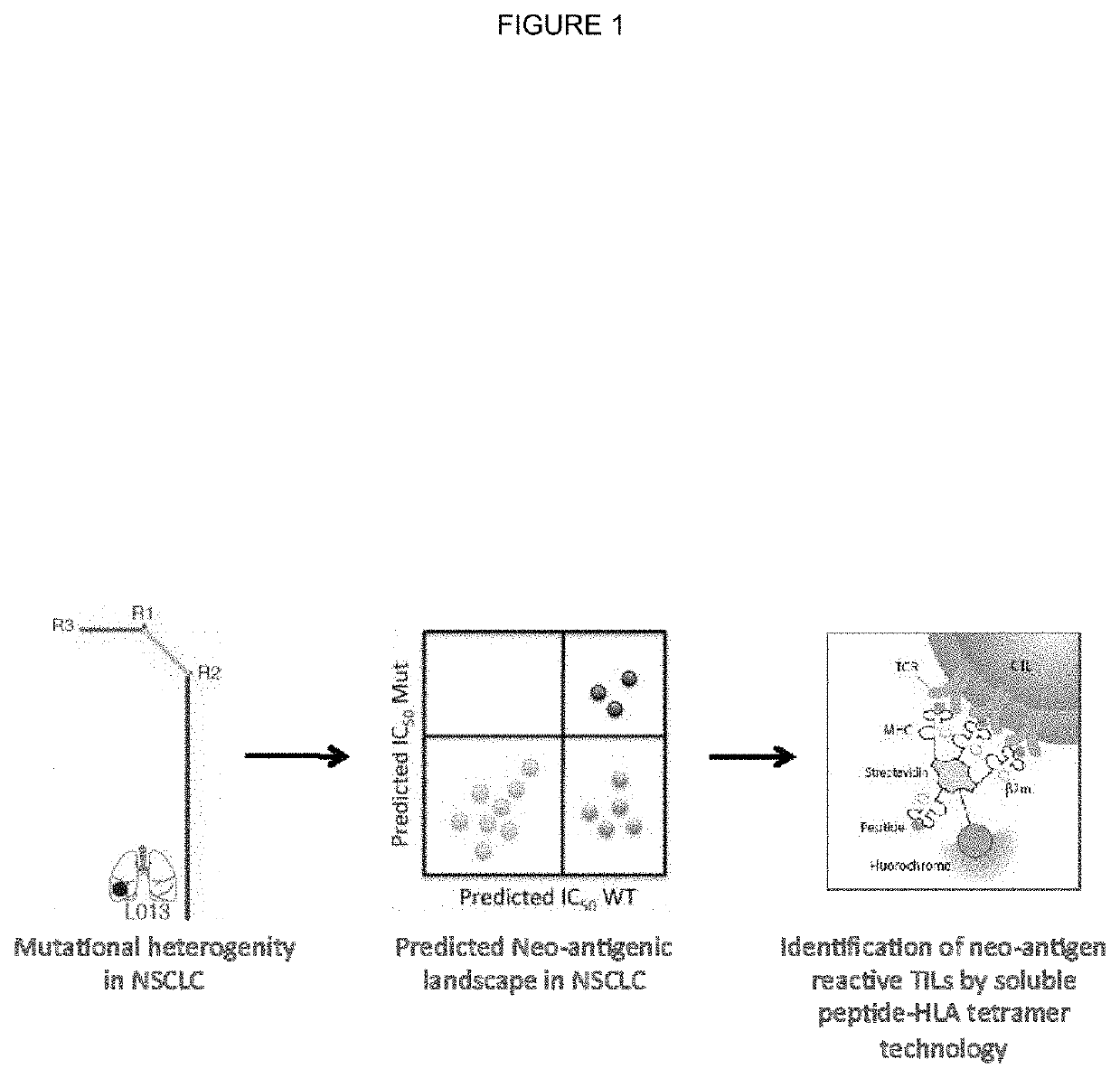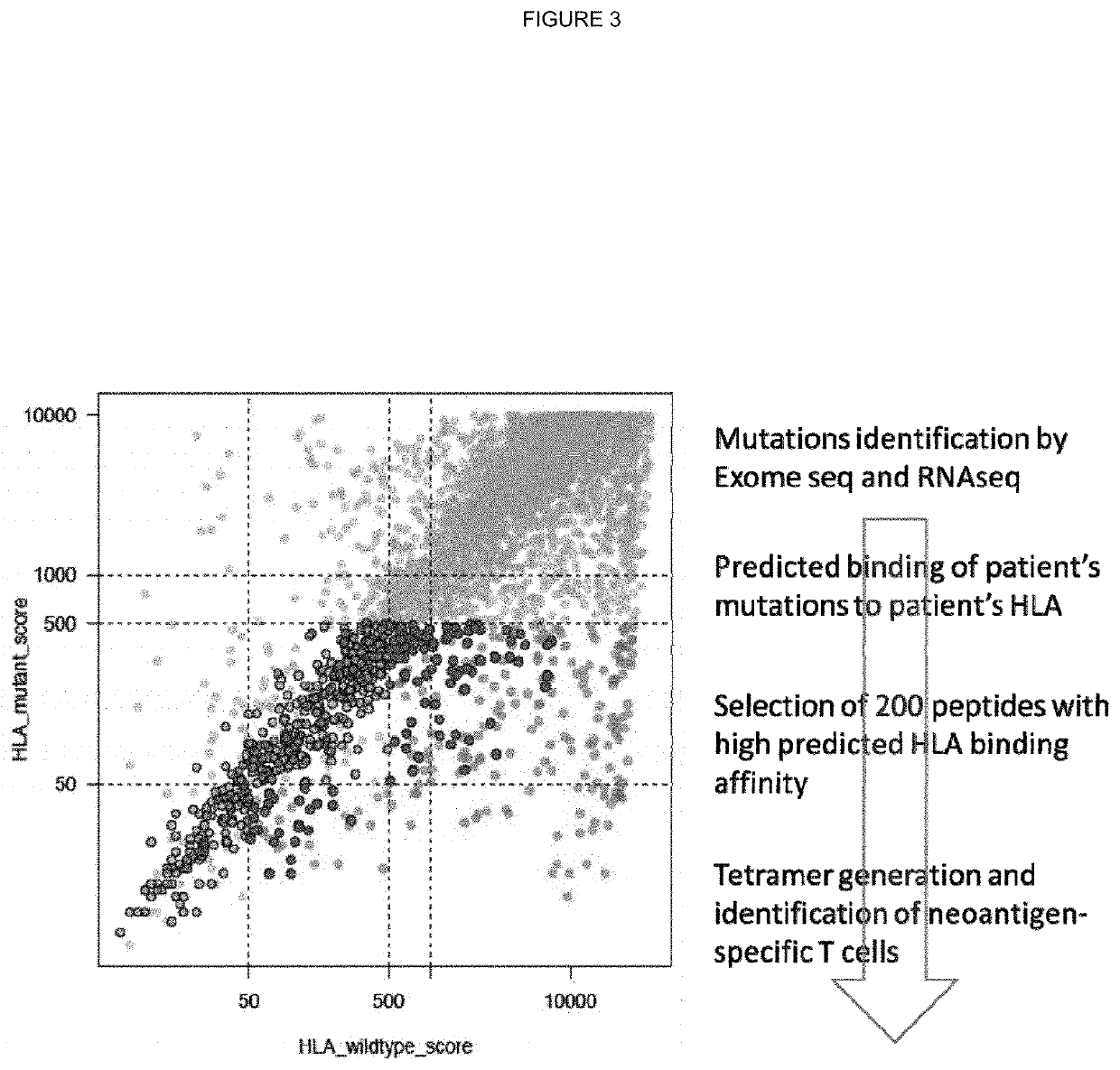Neo-antigen specific t cells
a technology of t cells and antigens, applied in the field of neoantigen specific t cells, can solve the problems of heterogeneous tumour population bottlenecks, significant challenges in designing effective treatment strategies, and large heterogeneous tumour population, so as to reduce the risk of resistant cells repopulating the tumour and achieve effective immune response
- Summary
- Abstract
- Description
- Claims
- Application Information
AI Technical Summary
Benefits of technology
Problems solved by technology
Method used
Image
Examples
example 1
ation of Truncal Neo-Antigens in Non-Small Cell Lung Cancer Tumours
[0301]Tumour samples from a non-small cell lung cancer (NSCLC) tumour were subjected to deep exon sequence analysis to determine the extent of intra tumour heterogeneity (ITH), mutational load in each tumour region and to distinguish mutations present in all tumour cells from those present in only a subset. In parallel, single cell suspensions generated from the same tumour regions were processed, aliquoted and stored for later in vitro analysis and expansion.
[0302]Identification of Single Nucleotide Variants from Exome Sequencing Data
[0303]Exome sequencing was performed on multi region samples isolated from NSCLC tumours. Raw paired end reads (100 bp) in FastQ format generated by the Illumina pipeline were aligned to the full hg19 genomic assembly (including unknown contigs) obtained from GATK bundle 2.8, using bwa mem (bwa-0.7.7) (Li and Durbin; 2009; Bioinformatics; 25(14):1754-60). Picard tools v1.107 was then ap...
example 2
Predictions
[0316]For each subject, germline whole exome sequencing FASTQ files were mapped to a reference FASTA file containing the sequences for known HLA alleles. Mapping was performed using Razers3 (Weese et al.; Bioinformatics; 2012; 28(20): 2592-2599) with a percent identity threshold of 90, a maximum of one hit, and a distance range of 0. Once mapped, the generated SAM files were converted to FASTQ and used as input to the Optitype prediction algorithm (Szolek et al.; Bioinformatics; 2014; 30(23):3310-3316) with default parameters. Optitype generates a predicted 4-digit resolution HLA type for each patient, which was stored for use in HLA-binding prediction.
[0317]HLA Binding Predictions
[0318]Coding mutations called from the tumour multi-region whole exome sequencing data were used to generate all possible 9-11mer mutant peptides from the neo-antigen, capturing the mutated amino acid in each position of the n-mer.
[0319]Thus, for a given SNV mutation, in total 446 peptides were ...
example 3
ation of Putative Truncal Neo-Antigens
[0321]All putative neo-antigens were classified as truncal or branched based on their cancer cell fraction in the tumour regions sequenced (as described in Example 1). Binding peptides that derive from a mutation found in every region of the tumour sequenced were identified as potential truncal neo-antigens (as described in Example 2).
[0322]Filtering of Putative Truncal Neo-Antigens Using RNAseq Data
[0323]All putative truncal neo-antigens were further filtered using RNA seq data. Specifically, the mean transcript length was used to convert from the calculated FPKM to TPM (transcripts per million) and identify putative truncal neo-antigen as those that are expressed at a median greater than 10 TPM.
PUM
| Property | Measurement | Unit |
|---|---|---|
| T cell composition | aaaaa | aaaaa |
| intra-tumoural heterogeneity | aaaaa | aaaaa |
| heterogeneity | aaaaa | aaaaa |
Abstract
Description
Claims
Application Information
 Login to View More
Login to View More - R&D
- Intellectual Property
- Life Sciences
- Materials
- Tech Scout
- Unparalleled Data Quality
- Higher Quality Content
- 60% Fewer Hallucinations
Browse by: Latest US Patents, China's latest patents, Technical Efficacy Thesaurus, Application Domain, Technology Topic, Popular Technical Reports.
© 2025 PatSnap. All rights reserved.Legal|Privacy policy|Modern Slavery Act Transparency Statement|Sitemap|About US| Contact US: help@patsnap.com



